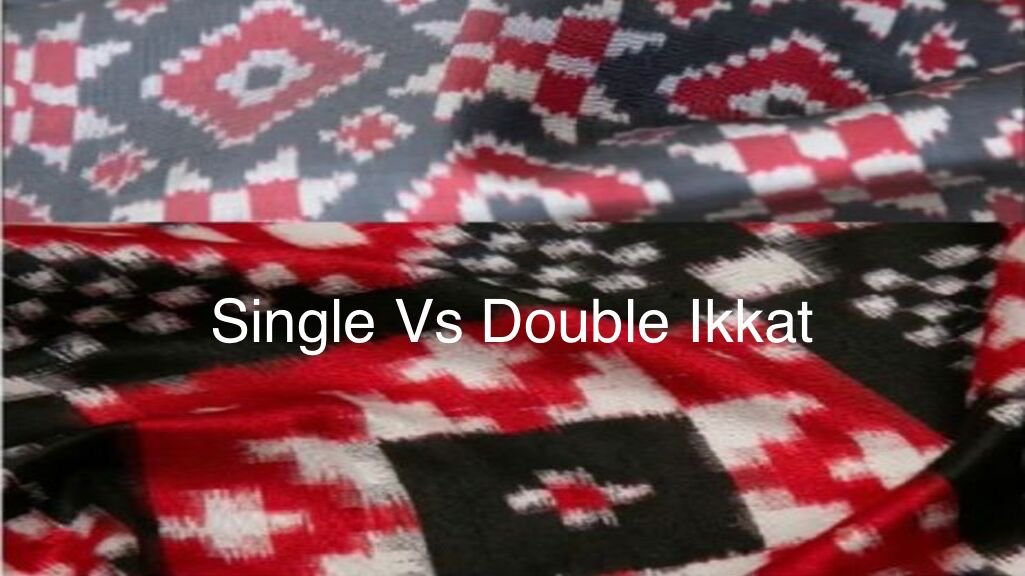
Weaving Stories, One Thread at a Time
The magic of Ikkat lies in its blur — not a flaw, but a feature. That slight feathering of patterns you see in an Ikkat saree or dupatta is the result of a centuries-old technique, where yarns are resist-dyed before being woven. It’s what gives Ikkat its unique soul.
But within Ikkat, there’s more to explore — especially when it comes to the difference between Single Ikkat and Double Ikkat. Both are stunning. Both are handcrafted. Yet, they differ in process, precision, and price.
Terms You Should Know
Warp
The warp refers to the vertical threads that are held taut on a loom during weaving. These are the foundation threads — strong, straight, and stretched from end to end.
In Ikkat, the warp yarns may be dyed in intricate patterns before weaving, depending on the technique used (like in single or double Ikkat).
Weft
The weft is the horizontal thread that is woven in and out of the warp to create the fabric. Think of it as the thread that travels across, interlacing with the warp to form the cloth.
In some Ikkat styles, the weft threads are dyed, while the warp is left plain.

Tie & Dye
The soul of Ikkat lies in the tie & dye technique. Before weaving even begins, threads are tied tightly with bindings in specific areas and then dyed. These tied sections resist the dye, creating patterns when untied.
This process may be repeated multiple times for different colors — all done by hand, and all based on complex mental mapping. No printed guides or stencils are used!
What is Single Ikkat?
In Single Ikkat, only one set of yarns — either the warp(vertical) or the weft(horizontal) — is tie-dyed before weaving. The other thread remains plain, helping to highlight the dyed design.
This version of Ikkat is more widely practiced and found in places like Pochampallyin Telangana and Sambalpurin Odisha. It offers a balance of traditional artistry and affordability, making it a favorite for sarees, stoles, and dress materials.
🔹 Simpler than double ikkat
🔹 Faster to produce
🔹 Great for everyday and festive wear
What is Double Ikkat?
Now, step into the world of Double Ikkat — where both warp and weft threads are dyed before weaving. This requires mathematical precision, perfect alignment, and extraordinary skill.
India’s most iconic double ikkat comes from Patan, Gujarat — the famed Patan Patola. These sarees take months, sometimes even a year, to complete. They are woven only by a few master artisans today and are often passed down through generations.
🔸 Rare and highly intricate
🔸 Takes longer to create
🔸 Highly prized, often used for weddings or heirlooms
Side-by-Side: Key Differences
| Aspect | Single Ikkat | Double Ikkat |
| Dyed Threads | Either warp or weft | Both warp and weft |
| Complexity | Moderate | Very High |
| Time Taken | Days or a few weeks | Months or even a year |
| Cost | More affordable | Premium, luxury segment |
| Pattern Clarity | Moderate alignment | Perfect precision needed |
Why It Matters
When you wear Ikkat, you wear a story. Each piece carries the mark of the artisan — their hands, eyes, and heart. Whether it’s the bold geometry of a single ikkat kurta or the mirror-image perfection of a Patola saree, you’re not just buying fabric — you’re preserving a tradition.
At Eternal Pehnawa
We celebrate the beauty of handcrafted textiles. Our Ikkat collection brings you the best of both worlds — accessible single ikkat styles and heritage-inspired double ikkat pieces. Sustainably sourced, artisan-made, and timelessly elegant.
Wear Ikkat. Wear Art.


Add comment